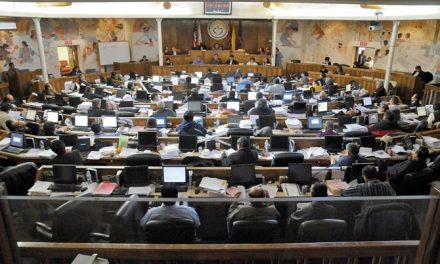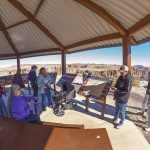
Diné poetics: language and performance as an avenue for preservation
By Robert Bettis
Navajo Times
Language is at the heart of Diné identity, carrying with it stories, traditions, and a worldview deeply rooted in the land and history of the Navajo people. As Diné poets, educators, and language advocates work to sustain Diné Bizaad, many are embracing poetry, playwriting, and performance as tools for preservation and revitalization.
Aresta Tsosie-Paddock is Naakaii Dine’é and born for Bįįh Bitoodnii. Her cheii is Tł’ízíłání and her nálí is Kinyaa’áanii. She is a linguist and instructor at the University of Arizona, where she integrates creative expression into her Navajo language courses. In her advanced classes, students write and perform plays entirely in Navajo, an immersive approach that challenges them to apply their language skills beyond the classroom.
“One of the most interesting projects my students take on is writing their own plays in Navajo,” Tsosie-Paddock explained. “It allows them to think deeply about storytelling in our language and how to convey meaning in a way that is culturally appropriate.”
Students in her courses have written plays that explore themes of traditional storytelling, contemporary Navajo experiences, and the struggles of maintaining tradition in the modern day. One challenge that they’ve faced is in adapting well-known stories, such as Shakespeare’s Romeo and Juliet, only to find that cultural differences changed how the story was told in a Diné context.
“There was a group that wanted to do Romeo and Juliet, but they had to reconsider how relationships and family dynamics work in Navajo culture. The final play turned out very different from the original story,” she said.
“This creative process also presents students with the opportunity for intergenerational learning,” Tsosie-Paddock said. “Many students speak to elders and family members while working on their plays, reinforcing the importance of community involvement in learning. They ask their grandparents, their parents, and neighbors for advice. It’s a way of bringing people together through language.”
Beyond the classroom, poets and teachers see creative writing as a crucial part of language revitalization. Cheyenne Dakota Williams, a Fort Lewis College student who studies Diné poetics, believes that poetry provides a way to make the language more accessible to the younger generation. “Poetry is a way to express emotions, ideas, and our worldview in ways that go beyond traditional language learning,” Williams said.
Williams is Bit’ahnii and born for Nahiłii. Her cheii is Tódích’íi’nii and her nálí is Nahiłii. Williams, whose work was recently featured in Poetry Magazine’s March issue, has been recognized for two poems about the hardships of her ancestors, and her personal experiences as a mixed Navajo woman, titled “How to Be a Drunk NDN and Heritage Diner.”
Another figure, Larencita Billy, who is leading the way in Diné poetics is a Navajo language teacher at Window Rock High School.
Billy is Tódích’íi’nii and born for Tsi’naajinii. Her cheii is Ta’neeszahnii and her nálí is Tsi’naajinii. She emphasizes the power of performance in engaging young learners. “When students hear Navajo being spoken creatively through poetry and plays, it makes them excited to learn. It shows them that our language is alive and evolving,” she said.
Tsosie-Paddock agreed, noting that while Navajo has primarily been an oral language, written scripts and performances help bridge traditional storytelling with a modern expression.
“It’s about creating new spaces for the language to exist. Whether through poetry, plays, or spoken word, these forms remind us that Navajo is not just a language of the past—it’s a language of the future,” Tsosie-Paddock said.
With Diné poetics gaining recognition as a powerful force for language preservation, educators and artists continue to weave words into the fabric of a thriving language – one that speaks to the spirit and strength of the Navajo people.








 Highway 264,
Highway 264, I-40, WB @ Winslow
I-40, WB @ Winslow